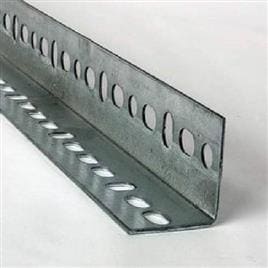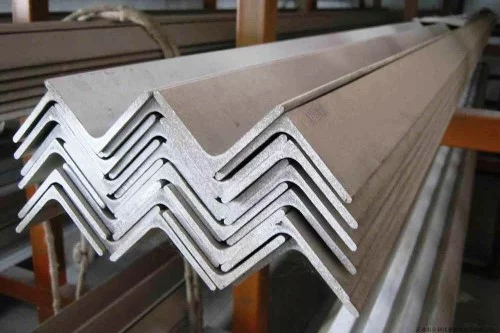When it comes to construction and manufacturing, choosing the right materials can make or break a project. Among the countless options available, mild steel angles stand out as unsung heroes, quietly contributing to the structural integrity of buildings, machinery, and infrastructure. In this in-depth exploration, we will delve deep into the world of mild steel angles, understanding their properties, applications, advantages, and why they are indispensable in the construction and manufacturing sectors (Angle Price).
Unveiling Mild Steel Angle
The Basics of Mild Steel
Let’s start with the basics. Mild steel, often referred to as low-carbon steel, is a type of carbon steel with a low carbon content, typically less than 0.3%. This characteristic gives it exceptional ductility and malleability, making it the top choice for a myriad of applications.
The Marvelous Properties
Now, let’s unravel the remarkable properties that make mild steel angles a preferred material:

1. Strength and Durability
Despite its low carbon content, mild steel exhibits impressive strength and durability, rendering it suitable for supporting substantial loads and withstanding external pressures.
2. Weldability
One of the standout features of mild steel is its exceptional weldability. Welders find it easy to work with, allowing for the creation of intricate structures with strong, reliable joints.
3. Corrosion Resistance
With appropriate coating or treatment, mild steel can achieve substantial corrosion resistance, extending its lifespan significantly.
Angle Price (Mild Steel Angle Price)
In India, the price of mild steel angles varies depending on factors like size, thickness, and market dynamics. On average, you can find standard-sized mild steel angles priced at around ₹40 to ₹80 per kilogram. However, for larger or specialized angles, the prices may vary. It’s recommended to obtain quotes from local suppliers for the most accurate and up-to-date pricing in India.
Angle Price with different Sizes (Mild Steel Angle):
| Type | Size (mm) | Thickness (mm) | Price per Meter (INR) |
|---|---|---|---|
| Equal Angle Price | 20×20 | 3 | ₹50 – ₹60 |
| Equal Angle Price | 30×30 | 4 | ₹70 – ₹80 |
| Equal Angle Price | 40×40 | 5 | ₹90 – ₹100 |
| Equal Angle Price | 50×50 | 6 | ₹110 – ₹120 |
| Equal Angle Price | 60×60 | 8 | ₹130 – ₹140 |
| Unequal Angle Price (L-Shaped) | 30×20 | 4 | ₹60 – ₹70 |
| Unequal Angle Price (L-Shaped) | 40×30 | 5 | ₹80 – ₹90 |
| Unequal Angle Price (L-Shaped) | 50×40 | 6 | ₹100 – ₹110 |
| Unequal Angle Price (L-Shaped) | 60×50 | 8 | ₹120 – ₹130 |
Diverse Applications of Mild Steel Angle
Construction Sector
- Building Construction: In the world of construction, mild steel angles are ubiquitous, serving as vital components in building frames, providing essential structural support and stability.
- Manufacturing: In manufacturing, these angles are indispensable for creating frameworks and supports for machinery and equipment.
Infrastructure Development
- Bridges and Flyovers: When it comes to large-scale infrastructure projects like bridges and flyovers, mild steel angles play a pivotal role in ensuring stability and durability.
Automotive Industry
- Automotive Engineering: The automotive industry relies on mild steel angles for fabricating vehicle frames and chassis due to their unmatched strength and malleability.
The Advantages of Choosing Mild Steel Angle
1. Cost-Effectiveness
Mild steel angles are renowned for being budget-friendly, making them the preferred choice for projects with financial constraints.
2. Versatility and Customization
Their versatility allows engineers and builders to customize mild steel angles according to specific project requirements, ensuring a perfect fit.
3. Low Maintenance
Mild steel angles require minimal maintenance, translating to reduced long-term operational costs.
4. Eco-Friendly Option
Choosing mild steel angles is also an environmentally responsible choice. Mild steel is fully recyclable, aligning with sustainable construction and manufacturing practices.
How to Make the Right Choice
Selecting the appropriate mild steel angle for your project is crucial. Here are some factors to consider:
1. Size and Dimensions
Begin by carefully assessing the size and dimensions of the mild steel angle. Ensure that it aligns with the structural requirements of your project.
2. Coating and Finish
Determine whether the angle requires additional coating or finishing to enhance its resistance to corrosion and environmental factors.
3. Load-Bearing Capacity
Evaluate the load-bearing capacity of the mild steel angle to ensure that it can safely support the anticipated loads.
Conclusion: The Unwavering Importance of Mild Steel Angles
In conclusion, mild steel angles are the unsung heroes of the construction and manufacturing worlds. Their unmatched strength, versatility, and affordability have earned them a well-deserved place at the forefront of various industries. Whether you are constructing a towering skyscraper or a small-scale machinery framework, mild steel angles provide the structural integrity and durability necessary for success. Embrace the advantages of this remarkable material in your next project, and you will undoubtedly reap the rewards.
Frequently Asked Questions:
-
Can mild steel angles withstand outdoor conditions?
Yes, they can. However, for extended outdoor use, consider applying a protective coating for enhanced corrosion resistance.
-
Are mild steel angles challenging to work with?
Not at all. Mild steel angles are known for their weldability and ease of fabrication, making them a favorite among builders and manufacturers.
-
What are the alternatives to mild steel angles?
Alternatives include stainless steel angles and aluminum angles, each with unique properties and ideal applications.
-
How can I prevent rust on mild steel angles?
To prevent rust, consider applying protective coatings or regular maintenance practices.
-
Is choosing mild steel angles environmentally friendly?
Absolutely. Mild steel is fully recyclable, making it an eco-friendly choice for projects that prioritize sustainability.
-
Can mild steel angles be painted for decorative purposes?
Yes, mild steel angles can be painted to enhance their aesthetic appeal. Painting not only adds a decorative touch but can also provide extra protection against corrosion.
-
What are the common sizes available for mild steel angles?
Mild steel angles come in a variety of sizes, ranging from small angles used in DIY projects to large structural angles for heavy-duty applications. Common sizes include 20x20mm, 40x40mm, 50x50mm, and larger, with varying thicknesses.
-
Are mild steel angles suitable for indoor applications?
Absolutely, mild steel angles are versatile and can be used for both indoor and outdoor applications. They are frequently utilized in indoor projects like shelving, framework, and structural supports.
-
How do I calculate the load-bearing capacity of a mild steel angle?
Determining the load-bearing capacity involves considering factors like the angle’s size, thickness, and the type of load it will bear. Engineering tables and calculations are commonly used to arrive at the specific load-bearing capacity for a given angle.
-
Are there any safety precautions to consider when working with mild steel angles?
Safety is paramount when working with any material, including mild steel angles. Ensure you have the appropriate personal protective equipment (PPE) when cutting, welding, or handling these angles. Additionally, proper ventilation in the workspace is crucial when working with welding equipment.
-
Can mild steel angles be recycled?
Yes, mild steel is fully recyclable, making it an environmentally friendly choice. Recycling mild steel angles reduces the demand for new raw materials and contributes to sustainable manufacturing and construction practices.
-
What is the shelf life of mild steel angles?
When properly stored and maintained, mild steel angles can last for many years. Regular inspections and maintenance, such as rust prevention measures, can extend their lifespan significantly.
-
Are there any industry standards for the production of mild steel angles?
Yes, several industry standards dictate the production and quality of mild steel angles, including those set by organizations such as ASTM (American Society for Testing and Materials) and EN (European Norms). Compliance with these standards ensures the angles meet specific quality and performance criteria.
-
Can mild steel angles be used in DIY projects?
Certainly, mild steel angles are a popular choice for DIY enthusiasts due to their ease of use and versatility. They can be employed in various DIY projects, including building shelves, tables, and even garden structures.
-
Are there any limitations to using mild steel angles?
While mild steel angles are incredibly versatile, it’s essential to consider their load-bearing capacity, especially in heavy-duty applications. In such cases, consulting with a structural engineer or expert is advisable to ensure safety and compliance with local building codes.
Recommended:
Neend ki Tablet Name and Price (2023) | A Comprehensive Guide to Sleep Aids

